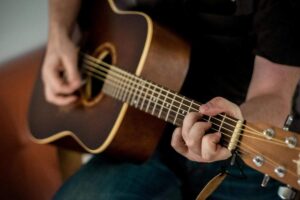Choosing the best guitar for a beginner is a critical step in starting your musical journey. When asking yourself, “What guitar should a beginner buy?” it’s essential to consider various factors that not only make learning more enjoyable but also ensure that you develop good playing habits from the start. Below is a more comprehensive guide on how to choose a guitar for beginners, focusing on finding what guitar is best to start with:
1. Budget: Setting the Foundation
Your budget is the first consideration when buying a guitar. When thinking about what guitar should a beginner buy, it’s tempting to go for the cheapest option, but investing in a slightly better-quality guitar can make a significant difference in your playing experience. A good beginner guitar typically ranges from $150 to $500. Remember, you’ll also need to budget for essential accessories like a tuner, strap, picks, and possibly an amplifier if you’re going electric.
2. Guitar Type: Finding Your Sound
Understanding how to choose a guitar type is crucial, as electric guitars come in various forms, each catering to different styles and tones:
- Solid-body guitars are the most common and are known for their versatility. They can be used in rock, pop, blues, and more.
- Semi-hollow guitars offer a warmer, more resonant sound, making them popular in jazz and blues.
- Hollow-body guitars provide rich, deep tones but are more prone to feedback, making them better suited for jazz or mellow genres.
Understanding the differences will help you determine what guitar is best to start with, matching your musical aspirations.
3. Body Shape and Weight: Comfort Matters
When considering what guitar should a beginner buy, the body shape and weight of a guitar significantly affect your playing comfort. For electric guitars, common shapes include the Stratocaster, Telecaster, Les Paul, and SG, each offering a different feel:
- Stratocaster: Known for its contoured body and versatility, it’s a popular choice for beginners.
- Telecaster: Slightly heavier with a straightforward design, ideal for country, rock, and blues.
- Les Paul: Heavier with a thicker body, offering a fuller sound, perfect for rock and metal.
- SG: Lighter with easy access to higher frets, good for rock and hard rock.
For acoustic guitars, body shape plays a crucial role in both the instrument’s sound and comfort. Here’s how to choose a guitar based on body shape:
- Dreadnought: The most popular shape, known for its large body and bold, balanced sound. It’s versatile and well-suited for strumming and flat-picking but can be bulky for smaller players.
- Concert and Grand Concert: Smaller than the dreadnought, these shapes offer a more focused, mid-range tone. They are easier to handle and comfortable for fingerpicking, making them a good choice for players with smaller hands.
- Auditorium and Grand Auditorium: These shapes strike a balance between the dreadnought and concert sizes, offering a full sound with a more comfortable size. They are versatile and work well for both strumming and fingerpicking.
- Jumbo: As the name suggests, this is the largest body shape, delivering a booming, bass-heavy sound. It’s ideal for players who want a powerful sound but may be too large for smaller players.
- Parlor: A smaller body shape that produces a warm, intimate sound, often favored by blues and folk musicians. It’s lightweight and easy to handle, making it great for travel and practice.
Whether choosing an electric or acoustic guitar, it’s essential to try out different shapes to find what feels most comfortable, especially if you plan on playing for extended periods. The right body shape will enhance your playing experience and help you decide what guitar is best to start with.
4. Pickups: Shaping Your Tone
Pickups are crucial in defining the sound of your guitar. The two main types are:
- Single-coil pickups: Provide a bright, crisp sound with more clarity, often used in blues, pop, and country.
- Humbucker pickups: Offer a thicker, warmer tone with more output, reducing unwanted noise, making them great for rock, metal, and jazz.
Understanding pickups is essential when considering what guitar should a beginner buy since they greatly influence the overall tone.
5. Brand and Quality: Trusting the Experts
When learning how to choose a guitar, it’s wise to stick with reputable brands known for producing quality instruments. Brands like Fender, Gibson, Squier, Epiphone, Yamaha, and Ibanez offer models that cater specifically to beginners, balancing quality and affordability. These brands have been trusted by musicians for decades and provide excellent customer support, ensuring that your first guitar is a reliable one.
6. Playability: The Feel of the Instrument
The playability of a guitar is about how comfortable it feels in your hands. Pay attention to:
String action: The height of the strings from the fretboard. Lower action makes the guitar easier to play but can lead to buzzing if too low.
Neck shape: Different neck shapes (C-shape, V-shape, etc.) fit different hand sizes and playing styles.
Fretboard radius: A flatter fretboard (larger radius) is better for soloing, while a more curved one (smaller radius) is better for chord playing.
Understanding these factors will guide you on how to choose a guitar that feels right and is easy to play.
7. Test and Compare: The Hands-On Approach
When deciding what guitar should a beginner buy, never purchase one without trying it first. Visit a music store, test out different models, and compare how they sound, feel, and play. Don’t hesitate to ask the store staff for recommendations or advice based on your musical preferences. Online reviews and demos can also provide additional insight, but nothing beats hands-on experience.
8. Inspiration and Motivation: The Most Important Factor
Ultimately, the best guitar for a beginner is the one that inspires you to pick it up and play. It should be an instrument that motivates you to practice and improve your skills. Whether it’s the look, the sound, or how it feels in your hands, choose a guitar that excites you and makes you want to keep playing.
Starting your guitar journey with the right instrument will set you on the path to success. Now that you know how to choose a guitar and have some insight into what guitar is best to start with, take your time to explore your options, and don’t rush the decision. Happy playing! If you’d like some advice on what guitar is best for you, book a free guitar consultation at Peak Music Studios, and we will be happy to help!








